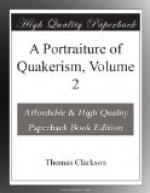The Quakers, however, have no objection, if a man has conducted himself particularly well in life, that a true statement should be made concerning him, provided such a statement would operate as a lesson of morality to others; but they think that the tomb-stone is not the best medium of conveying it. They are persuaded that very little moral advantage is derived to the cursory readers of epitaphs, or that they can trace their improvement in morals to this source. Sensible, however, that the memorials of good men may be made serviceable to the rising generation, ("and there are no ideas, says Addison, which strike more forcibly on our imaginations, than those which are raised from reflections upon the exits of great and excellent men,”) they are willing to receive accounts of the lives, deaths, and remarkable dying sayings, of those ministers in their own society, who have been eminent for their labours. These are drawn up by individuals, and presented to the monthly meetings, to which the deceased belonged. But here they must undergo an examination before they are passed. The truth of the statement, and the utility of the record, must appear. It then falls to the quarterly meetings to examine them again, and these may alter, or pass, or reject them, as it may appear to be most proper. If these should pass them, they are forwarded to the yearly meeting. Many of them, after this, are printed; and, finding their way into the bookcases of the Quakers, they become collected essays of morality, and operate as incitements to piety to the rising youth. Thus the memorials of men are made useful by the Quakers in an unobjectionable manner; for the falsehood and flattery of epitaphs are thus avoided; none but good men having been selected, whose virtues, if they are recorded, can be perpetuated with truth.
SECT. III.
They discard also mourning garments—These are only emblems of sorrow—and often make men pretend to be what they are not—This contrary to Christianity—Thus they may become little better than disguised pomp, or fashionable forms—This instanced in the changes and duration of common mourning—and in the custom also of court-mourning —Ramifications of the latter.
As the Quakers neither allow of the tomb-stones, nor the monumental inscriptions, so they do not allow of the mourning garments of the world.
They believe there can be no true sorrow but in the heart, and that there can be no other true outward way of showing it than by fulfilling the desires, and by imitating the best actions, of those whom men have lost and loved. “The mourning, says William Penn, which it is fit for a Christian to have on the departure of beloved relations and friends, should be worn in the mind, which is only sensible of the loss. And the love which men have had to these, and their remembrance of them, should be outwardly expressed by a respect to their advice, and care of those they have left behind them, and their love of that which they loved.”




